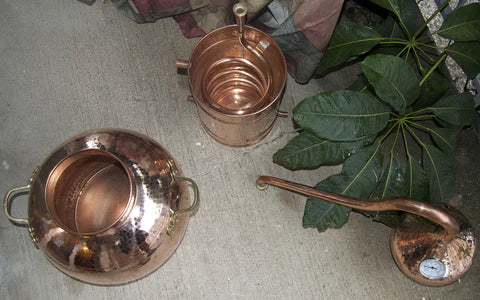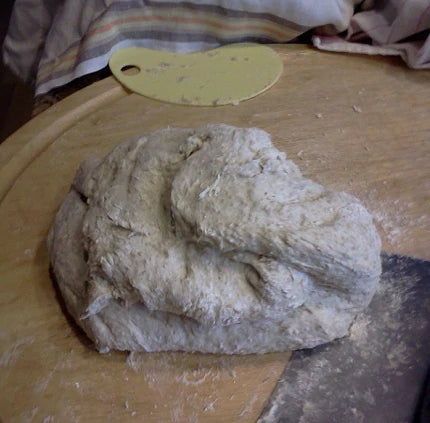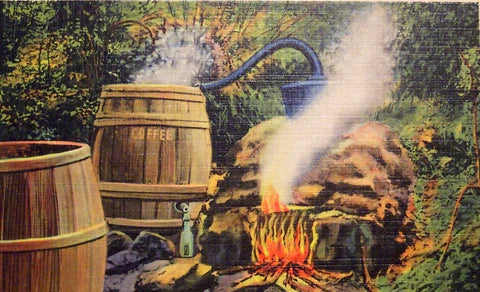When you purchase your copper whiskey still, you will be struck by its beauty, shine, and sturdy design. As striking as it looks, what a copper still was made for is making fine distilled products.
Whiskey and moonshine stills for sale online typically arrive at your home in pieces, ready to be assembled and to begin producing the finest spirits, distilled water, and essential oils. Or so you might think.
After manufacture, copper stills are not always cleaned. In addition, a still may come into contact with dust on the road while being shipped to you, which will contaminate your whiskey production. Even if your still was sterile when made, it is probably not sanitary when it arrives to you. Before you begin using it to produce any consumer products, you will want to thoroughly wash, clean, and prepare your moonshine still.
A thorough initial cleaning
After you order the copper whiskey still that’s the right size and design for your needs, take a trip to the store to pick up some white vinegar. A lot of it. About as many gallons as your still’s capacity - so, buy 10 gallons of white vinegar if you bought a 10 gallon whiskey still. You may not need it all at once, but the investment will be worth it in the long run.

Once your whiskey still arrives, and you have checked all the pieces thoroughly for defects or anything questionable, you want to clean each piece before assembling the still.
Mix a solution of 50% hot water and 50% vinegar. Fill the pot still approximately half-way with this mixture, and use a brand-new, never-before-used toilet brush to scrub the inside entirely. Use additional water-vinegar mixture and a carboy cleaning brush to scrub the condenser coil and onion head, as thoroughly as possible. Rinse clean.
After this initial cleaning, set everything aside to dry thoroughly. You are now ready for your vinegar run.
The Vinegar Run
Performing a vinegar run on the still before actually running any product through it is the best way prepare all the inner surfaces of your still. Make sure they are clean and ready for use, or your final distillate will end up with microorganisms and trace materials that cause off-flavors or strange scents.
1. Fill the Pot.
Fill the pot of your still to about 20% capacity with a mixture of 50% white vinegar and 50% clean water. That’s about 1 gallon of the mixture in a 5 gallon still, or 2 gallons in a 10 gallon still. Use distilled water for this mixture, if you have some available.
2. Prepare the Still
Set up your whiskey still on its heat source. Assemble your still as if you were going to make a moonshine or whiskey run. Seal the seams with your flour-paste mixture, so you can observe your paste’s durability and fine-tune that recipe if you need to. This will also help you check your seals for leaks, which you should be prepared to take care of before you start distilling any product. Set up the collection container, although you won’t be keeping any of the liquid from the vinegar run.
For your vinegar run, you do not want to set up your cooling system for the condenser coil. You want the hot vinegar to run through the coil so that it cleans as much of the interior of the coil as possible.
3. Run the Vinegar Water
Turn on the heat and bring the water and vinegar mixture to a boil. Keep an eye on the thermometer and adjust the temperature as needed. You may see steam come out of the condenser coil and liquid begin to collect in the collection cup when the onion head reaches around 170 degrees Fahrenheit. However, you can take the temperature up to a level where the water will boil, when the onion head reads about 200 degrees Fahrenheit.
Keep in mind, at that temperature your copper moonshine still will be extremely hot, and the steam can cause substantial burns. Be sure to always use proper safety equipment.
4. Cut Heat and Cool It
Once the onion head thermometer on your still has been at a temperature over 170 degrees Fahrenheit for about 5 minutes, and hot steam and water-vinegar mixture have been coming out of the condenser coil, you can turn off the heat. Keep a large container available to continue to collect any liquid which drips from the coil, but you should see less as the temperature in the still gradually decreases.
Allow the entire still to cool before disassembling, to avoid serious injury. Empty the water-vinegar mixture and towel-dry the interior of the still’s pot and onion head as much as possible. You might run some cool, clean water through the condenser coil as well, but it isn’t absolutely necessary.
Your copper moonshine still is now be ready to produce the fine products you have been looking forward to.
When should I do a vinegar run?
You can perform a vinegar run as often as you want, but most distillers use it as a deep-clean on their most used stills about twice per year. Set a date on your calendar to regularly clean your still with a vinegar run if you will be using your still to regularly produce the same product.
If you are using the same still to produce multiple distillates, you might complete a vinegar run before switching between products. So, if your last run was a peach moonshine and your next run is going to be a hearty whiskey, you might do a vinegar run between the two so the flavors don’t get mixed. This is especially important if you will be using your still for multiple essential oils, as the delicate scents and flavors of an oil can be easily affected by residual oils left over from previous runs.
Lastly, consider doing a vinegar run any time you move your still from one location to another, or if it sits out of use for a long time. A still that is used for decoration for years and then put to work may be contaminated with any number of dust particles, pet hair, or insects, and a vinegar run will remove all of that.
Vinegar runs are simple, effective ways to keep your copper still performing at its best for years to come. There’s no such thing as too many vinegar runs, so don’t worry about overdoing it. Keeping your whiskey or moonshine still clean and operational shows that you’re serious about the quality of products you make, and that you are always dedicated to making your at-home essential oils, distilled water, or alcohol responsibly.
Article by: Jim Thomas
Photo Credit: "Heinz White Vinegar" by Mike Mozart



